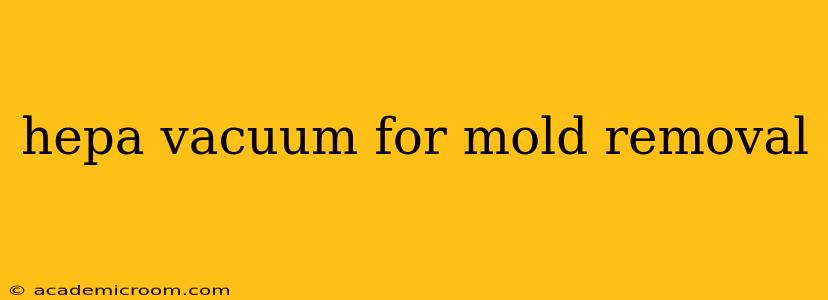Mold infestations are a serious concern, impacting indoor air quality and potentially causing health problems. A crucial step in mold remediation is thorough cleaning, and a HEPA vacuum plays a vital role in this process. This guide explores the effectiveness of HEPA vacuums for mold removal, addressing common questions and concerns.
What is a HEPA Vacuum and How Does it Work?
HEPA stands for High-Efficiency Particulate Air. A HEPA vacuum cleaner uses a specialized filter that captures at least 99.97% of particles 0.3 microns in size or larger. Mold spores, being microscopic, are easily trapped by these filters, preventing them from being released back into the air during cleaning. Unlike standard vacuums, HEPA vacuums effectively minimize the risk of spreading mold spores further, making them essential for mold remediation. The powerful suction of the vacuum removes mold and other debris from surfaces, while the HEPA filter ensures that the cleaned air is cleaner than before.
Can a HEPA Vacuum Completely Remove Mold?
While a HEPA vacuum is a valuable tool, it's crucial to understand its limitations. It's highly effective at removing surface mold and spores, but it won't address the underlying source of the mold problem. For extensive mold growth, professional mold remediation is necessary. A HEPA vacuum is best used as part of a larger mold removal strategy, supplementing other methods rather than acting as a standalone solution.
What are the Best HEPA Vacums for Mold Removal?
Selecting the right HEPA vacuum depends on the extent of the mold infestation and the surfaces you'll be cleaning. Features to consider include suction power, filter type (true HEPA filters are crucial), and versatility (various attachments for different surfaces). Researching reviews from reputable sources will help you find a model that meets your specific needs. Consider also the size and type of area you need to cover; a larger area might necessitate a more powerful, potentially canister-style vacuum, whereas a smaller space might be adequately addressed by a lightweight upright HEPA vacuum.
How to Effectively Use a HEPA Vacuum for Mold Removal
Before using your HEPA vacuum, always wear appropriate personal protective equipment (PPE), including an N95 respirator mask, gloves, and eye protection. This protects you from inhaling mold spores and prevents skin irritation. Begin by thoroughly inspecting the affected area, identifying the extent of the mold problem. Start cleaning in the least contaminated area and work your way towards the most heavily affected areas. After cleaning, carefully dispose of the vacuum bag or empty the dustbin in a sealed bag, ensuring the used materials are properly contained. Remember to clean the HEPA filter according to the manufacturer's instructions. Replacing the filter regularly is essential to maintaining the vacuum's effectiveness.
How Often Should I Replace the HEPA Filter in My Vacuum?
HEPA filter replacement frequency varies depending on usage and the extent of mold exposure. Consult your vacuum's user manual for specific recommendations. However, it's generally advisable to replace the filter after each major cleaning session involving mold. Regular inspection will also help determine when replacement is necessary; a visibly dirty or clogged filter needs immediate replacement.
Can I Use a Shop Vacuum with a HEPA Filter for Mold Removal?
Shop vacuums can offer superior suction power compared to household models, making them effective for removing larger quantities of mold. However, ensure the vacuum has a true HEPA filter, not just a standard filter marketed as HEPA. The filter's efficacy is crucial to prevent mold spore release. Also remember that shop vacs are often bulkier and less maneuverable than household HEPA vacuums.
Is a HEPA Vacuum Better Than Other Methods for Mold Removal?
HEPA vacuums are effective for removing surface mold and spores, but they are not a replacement for other mold removal methods, such as professional cleaning, mold remediation, or the use of specialized cleaning products, especially for extensive or embedded mold problems. A multi-pronged approach, using appropriate tools and techniques depending on the severity and location of the mold growth, is most effective.
What Should I Do After Using a HEPA Vacuum for Mold Removal?
After vacuuming, it is essential to thoroughly clean the area with an appropriate mold-killing solution. Properly cleaning the area helps prevent mold regrowth. This includes cleaning all surfaces that were affected by mold. Proper ventilation is also crucial to allow the area to dry completely and discourage mold growth.
Remember, tackling mold requires a comprehensive approach. A HEPA vacuum is a valuable tool in your arsenal, but it's not a standalone solution. For extensive mold problems, contact a professional mold remediation specialist for safe and effective removal.
